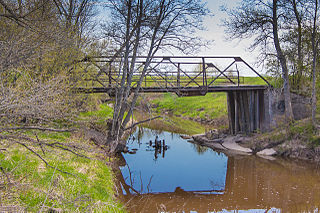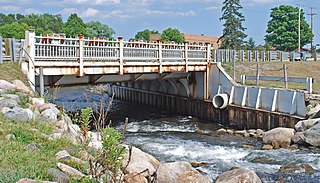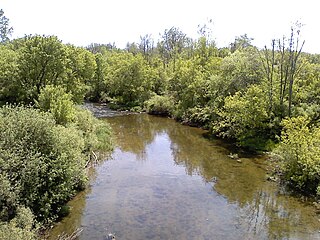
The American Legion Memorial Bridge is a reinforced concrete arch bridge carrying South Cass Street over the Boardman River in Traverse City, Michigan. It was completed in 1930 and listed on the National Register of Historic Places in 2000.

The Jefferson Avenue–Huron River and Harbin Drive–Silver Creek Canal Bridges are two separate bridges, sharing a continuous railing, that were jointly listed on the National Register of Historic Places on February 10, 2000.

The Arrawanna Bridge is a historic bridge, spanning the Coginchaug River near Berlin Street in Middletown, Connecticut, USA. Built in 1918, it is an early example in the state of an open-spandrel concrete arch bridge, and is one of the state's oldest bridges. It was listed on the National Register of Historic Places in 2004. The bridge is now closed to all traffic.

The County Road C117–Pike River Bridge is a steel stringer bridge located on County Road C117 over the Pike River just south of Chassell, Michigan. The bridge was placed on the National Register of Historic Places in 1999.

The M-28–Sand River Bridge is a bridge located on M-28 over the Sand River in Onota Township, Michigan. It was listed on the National Register of Historic Places in 1999.

The Canyon Falls Bridge is a bridge located on US Highway 41 (US 41) over the Sturgeon River in L'Anse Township, Michigan. It was listed on the National Register of Historic Places in 1999.

The Main Street–Black River Bridge is a bridge located on Main Street over the Black River in Ramsay, Bessemer Township, Michigan. It was listed on the National Register of Historic Places in 1999.

The Mansfield Road–Michigamme River Bridge is a bridge located on Mansfield Road over the Michigamme River in Mansfield Township, Michigan. It was listed on the National Register of Historic Places in 1999.

The US 2–Iron River Bridge is a bridge located on Genesee Street over the Iron River in Iron River, Michigan. It was listed on the National Register of Historic Places in 1999.

The Parker Road–Charlotte River Bridge, also known as the 10 Mile Road–Charlotte River Bridge, is a bridge building located on Parker Road over the Charlotte River in Bruce Township, Michigan. It was listed on the National Register of Historic Places in 2000.

The Ames Creek Bridge is an historic structure located northeast of DeWitt, Iowa, United States in rural Clinton County. It is an early example of concrete bridge design prior to the codification of standards by the state highway commission. The bridge was listed on the National Register of Historic Places in 1981.

The North 21st Street Bridge in Tacoma, Washington was built in 1910. It was designed by engineers Waddell & Harrington and is a continuous concrete rigid-frame girder bridge. It is significant as one of the very earliest examples of its type. It was built "almost simultaneously" with the 950-foot (290 m) Asylum Avenue Aqueduct in Knoxville, Tennessee, which was documented by Carl W. Condit to be the first continuous concrete girder bridge to be built.

The North 23rd Street Bridge in Tacoma, Washington, United States, is a concrete rigid frame bridge that was designed by engineers Waddell & Harrington in 1909. It was built for the City of Tacoma by contractors Creelman, Putman, and Healy.

The Second Street Bridge is a one-lane, single-span truss bridge in Allegan, in the U.S. state of Michigan, that carries Second Street over the Kalamazoo River. It is a Michigan State Historic Site, a National Historic Civil Engineering Landmark, and is listed on the National Register of Historic Places. Built in 1886, the bridge replaced an earlier wooden structure. In the early 1980s, the bridge underwent significant renovation.

The Indian Creek Bridge is a wrought iron bridge, built about 1880 to the east of Cedar Rapids, Iowa. The bridge crosses a tributary of the Cedar River in Linn County. It was designed and built by the Wrought Iron Bridge Company (WIBCO) of Canton, Ohio as an eight-panel pin-connected through truss in an unusual double-intersection Pratt design.

The M-72–Au Sable River Bridge, also known as the Grayling Bridge or State Street Bridge, is a bridge located on M-72 over the Au Sable River in Grayling, Michigan. It was listed on the National Register of Historic Places in 1999.

The Crystal Springs Street–Dowagiac River Bridge is a road bridge that carries Crystal Springs Street over the Dowagiac River near Sumnerville, Michigan. It was installed in that location in 2017. Between 1938 and 2016, the bridge was located approximately 50 miles away, and carried M-86 over the Prairie River near Nottawa, Michigan, and was known then as the M-86–Prairie River Bridge. The bridge was listed on the National Register of Historic Places in 2000, and is the last remaining camelback pony truss bridge used on the state trunkline system in Michigan.

The Grinnell Brothers Music House is a commercial building located at 27 South Saginaw Street in Pontiac, Michigan. It was listed on the National Register of Historic Places in 1984.

The Derby Street-Grand Trunk Western Railroad Bridge is a bridge carrying Derby Street over the Grand Trunk Western Railroad in Birmingham, Michigan. It was listed on the National Register of Historic Places in 2000.

The Trowbridge Road-Grand Trunk Western Railroad Bridge is a bridge carrying Trowbridge Road over the Grand Trunk Western Railroad in Bloomfield Hills, Michigan. It was listed on the National Register of Historic Places in 2000.

























